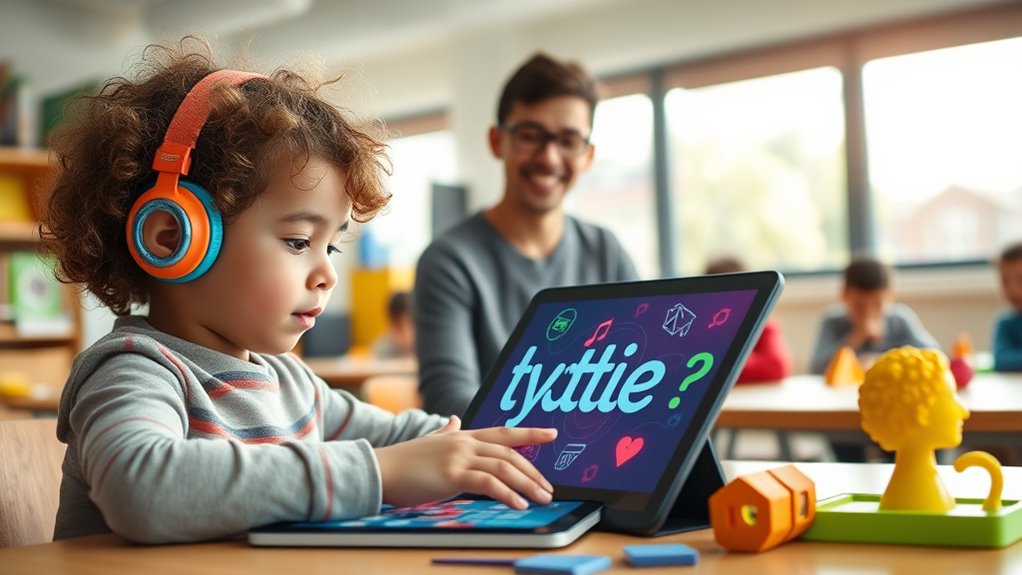AI helps you support students with dyslexia by enabling early detection through handwriting analysis, which can identify signs before traditional methods do. It personalizes learning with tailored exercises and immediate feedback, keeping students engaged and motivated. AI also supports classroom integration by providing performance insights and promoting collaboration. Visual aids and ongoing progress updates empower parents and educators alike. Keep exploring how these tools can make a difference in supporting dyslexic learners more effectively.
Key Takeaways
- AI-powered handwriting analysis enables early detection of dyslexia and dysgraphia, facilitating timely interventions.
- Personalized AI learning platforms adapt content and provide real-time feedback to support individual student needs.
- Classroom AI tools offer performance insights, helping teachers target interventions and enhance instructional strategies.
- Visual and interactive AI supports improve comprehension, engagement, and accessibility for students with dyslexia.
- Ongoing AI monitoring and parental updates ensure early support, track progress, and prevent academic setbacks.

Artificial Intelligence is transforming how we support students with dyslexia by enabling early detection and personalized learning. With AI-powered handwriting analysis, you can identify signs of dyslexia and dysgraphia in young children much earlier than traditional methods allow. These tools analyze visual, motor, and cognitive aspects of handwriting, helping you spot behavioral cues and cognitive struggles that might otherwise go unnoticed. This streamlined screening process is faster and more scalable, making it easier to serve larger populations and reduce delays in diagnosis. Plus, AI’s cost-effectiveness means schools and clinics can allocate resources more efficiently, lowering the expenses tied to lengthy, manual assessments.
AI tools also make early intervention more accessible, especially in underserved communities where specialized professionals may be scarce. By providing quick, reliable screening results, these tools allow you to implement support strategies sooner, improving students’ chances of success. Once identified, students benefit from AI-assisted learning platforms that tailor educational content to meet their specific needs. These systems offer personalized feedback on reading, spelling, and grammar exercises, helping students practice and improve at their own pace. Adaptive learning environments adjust in real-time, ensuring that each student receives appropriate challenges and support to stay engaged and motivated.
Immediate feedback from AI tools enables students to track their progress continuously, giving them a sense of control over their learning journey. Many of these tools also incorporate accessibility features like text-to-speech or speech-to-text, which break down barriers and make reading and writing more accessible. This individualized approach ensures that instruction aligns with each student’s unique strengths and difficulties, making learning more effective and less frustrating. Additionally, integrating high-quality projectors into classroom settings can enhance visual learning and engagement for students with dyslexia by providing clear and customizable visual aids. Research also suggests that combining visual supports with AI can further improve comprehension and retention.
In classroom settings, AI can seamlessly integrate into curricula, supporting teachers by providing insights into student performance and highlighting areas needing attention. This helps you target interventions more precisely and manage your classroom more effectively. AI also analyzes data from assignments and assessments, revealing patterns that indicate where students might struggle, thereby guiding your instructional decisions. Additionally, AI facilitates collaborative learning by offering tools that promote peer interaction, fostering a supportive environment for students with dyslexia. Research indicates that combining AI with multisensory teaching methods can significantly improve learning outcomes for dyslexic students.
Beyond academics, AI detects behavioral cues linked to dyslexia, such as motor difficulties and cognitive signs, while also offering emotional support through interactive interfaces. It encourages motivation and engagement by making learning fun and interactive. AI tools can provide parents with regular updates on their child’s progress, along with suggestions for home-based support. By identifying signs of dyslexia early, AI helps prevent significant academic setbacks, ensuring students receive the help they need when it matters most. Overall, AI offers an extensive approach to supporting dyslexic students, transforming educational experiences and opening new pathways for success. Utilizing early detection techniques can further enhance these supports by enabling even more timely interventions.
Frequently Asked Questions
How Does AI Personalize Learning for Each Dyslexic Student?
You ask how AI personalizes learning for each student. AI analyzes your individual learning patterns, adjusting content and pace to match your needs. It offers real-time feedback, helping you improve quickly. AI tools simplify complex texts, provide audio options, and create visual aids, making learning easier and more engaging. This tailored approach boosts your confidence, keeps you motivated, and guarantees you get the support you need to succeed.
What Challenges Exist in Implementing AI Tools in Classrooms?
Imagine trying to code a new app with dial-up internet—it’s challenging. Similarly, you face hurdles when implementing AI tools in classrooms. You might struggle with high costs, limited infrastructure, or lack of training. Data privacy concerns and ensuring consistent quality also pose issues. Plus, gaining teacher, parent, and student acceptance takes time. Overcoming these obstacles requires strategic planning to make AI accessible, effective, and trustworthy in supporting diverse learning needs.
Are There Privacy Concerns With AI Data Collection on Students?
Yes, there are privacy concerns when AI collects student data. You need to be aware of risks like data breaches, misuse, and identity theft, which can compromise sensitive information. Teachers and schools must guarantee proper data protection, obtain clear consent, and follow legal regulations. Using encryption, anonymization, and regular audits can help safeguard student privacy and build trust in AI tools.
How Cost-Effective Are AI Solutions for Schools With Limited Budgets?
Think of AI solutions as a cost-effective shortcut through a busy maze. For schools with limited budgets, these programs can cost less than 10% of traditional services per student, saving significant money. In New York, AI costs just 1% of what’s spent on special education. Plus, they’re quick to implement and require minimal training, making them a smart, scalable choice that stretches resources further and delivers faster results.
What Training Is Needed for Teachers to Effectively Use AI Tools?
You need targeted training to effectively use AI tools in your teaching. This includes understanding AI capabilities, customizing tools to meet student needs, and developing technical skills to operate software and hardware. Participating in workshops, online courses, and peer mentoring helps build confidence. Additionally, learning how to analyze data from AI tools allows you to monitor progress and adapt your teaching strategies, ensuring a truly personalized learning experience.
Conclusion
Imagine a world where over 15% of the population, roughly 1 in 7 people, benefits from AI tools tailored for dyslexia. These technologies don’t just make reading easier—they boost confidence, independence, and academic success. As you embrace AI’s potential, you’re helping create inclusive classrooms where every student, regardless of challenges, can thrive. The future is brighter when technology bridges gaps, turning obstacles into opportunities for all learners.











